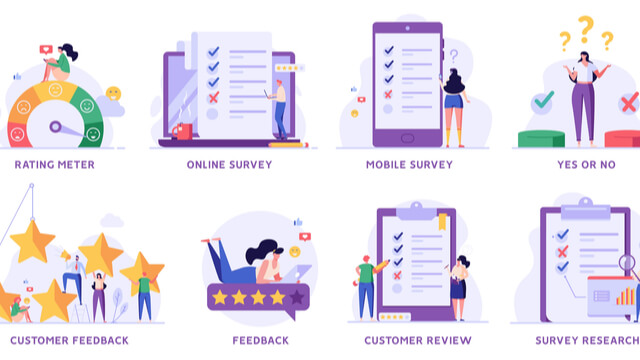The Four Voice-of-the-Customer Project Types

Voice of the Customer projects often stumble right out of the gate. Why is this? More often than not, projects begin with optimism and energy. But all too often, somewhere in the middle, they tend to lose momentum altogether. And once the enthusiasm begins to fade, it’s challenging to recapture the magic. But why does this happen? A hint can be found within this quote by Henry Kissinger, “If you do not know where you are going, every road will get you nowhere.”
With Voice of the Customer projects, all too often, the root cause is that we’ve never asked the question, “How will customer insight help?” If we fail to consider this, then we may find that in the end, we’ve learned things that are interesting but not actionable. And that’s not good enough.
Begin with the NPD project’s goals
It’s critical to consider the new product development goals from the start. That is, why are we doing this project? And again, how will customer insight help? While there could be many reasons, most have one of the following four objectives for Voice of the Customer projects. They are to…
- Learn the unknown unknowns and generally explore a market
- Search within a market for unmet customer needs to generate new product ideas
- Find opportunities to improve a defined product, typically for the purposes of developing the next generation
- Determine how well a concept addresses a list of defined customer needs
If a product team will take a moment to select the proper objective, they will likely be on the path to success. Example questions to consider include:
- Do we have a new product concept or idea in mind?
- Are we more interested in just generally exploring a market or, instead, are we interested in quantifying market opportunities?
- Is the broader new product initiative within our core, an adjacent (but close) market, or far from our core?
- Are we expected to generate new product ideas after this Voice of the Customer project?
After a careful meditation of our internal goals, we can select the Voice of the Customer project type that will best help us to achieve those goals. Let’s look at these four types.

The Exploratory Project
We conduct an Exploratory Project when we’re in the initial stages of seeking to understand an unfamiliar market. The objective is to generate initial thoughts about potential market opportunities. You’ll entertain questions such as:
- What problems are customers having?
- How satisfied are they with current products?
- What market segments might exist?
After an Exploratory Project, you’re not going to be ready to generate new product ideas quite yet. You won’t be ready as you’re not going to be confident about any findings. You will not have that depth of knowledge. On the positive side, exploratory project team members should not feel pressure. Further, there’s no need to be too obsessive about sample sizes or composition. You’re truly just exploring.
Exploratory research is usually only qualitative in nature, meaning that no surveys will be used. New Product Blueprinting practitioners can use Step 1 (Market Research) and Step 2 (Discovery Interviews) as a template for an Exploratory project.
In practice, it’s common that this will be the launching pad for a more in-depth Voice of the Customer project. This subsequent type, designed to quantify new opportunities is called a Market Opportunity Project.
The Market Opportunity Project
The goal of a Market Opportunity Project is to produce a prioritized list of customer needs. Most commonly, teams will use these priorities to generate new product ideas. Classically, a Market Opportunity Project will have a qualitative phase, in which the purpose is to produce a large list of customer needs, and a quantitative phase, in which we seek to prioritize that list.
During qualitative, it’s important to ensure customer diversity so that you can be confident that you’ve uncovered all the needs from within a market. Later, during the quantitative research (which often implies a survey), it’s important to use a representative sample for the targeted market. Further, the sample size must be sufficiently large to have confidence in the results.
New Product Blueprinting practitioners most often think in these terms for their “Blueprinting Projects,” using Blueprinting Steps 1-3. Upon completion, practitioners should allow for plenty of data analysis time to ensure they’ve found a market segment worth targeting.
The Market Opportunity Project provides actionable results. The most important and least satisfied needs represent market opportunities (thus, the name). These are “problem statements” that teams can use for many purposes such as idea generation, product tweaks, marketing, strategy, and even sales messaging.
If the innovation goals are strategic and long-term in nature, the Market Opportunity Project will study a market from a product-neutral perspective, using the customer’s Job-to-be-Done as the primary scope. However, in practice, it’s common that the goal is shorter-term in nature, in that the objective is to build the next generation of a current product. This gives us the next Voice of the Customer project type, The Next Generation Voice of the Customer Project.
The Next Generation Voice of the Customer Project
For many new product efforts, the scope is well-defined in that you’re already making Product A, and it’s time for an update. The new product will share much of the same architecture as the old. You’re just looking for tweaks, for a few easy-to-add features. This project will, in fact, be similar to the Market Opportunity Project, but with this difference: the customer needs will be more about consumption and use of the product as opposed to its core function.
This project’s scope will include a list of consumption jobs-to-be-done, such as:
- Purchase the product
- Receive the product
- Learn to use the product
- Use the product
- Upgrade the product
- Dispose of product
If unfamiliar with jobs-to-be-done, the distinction may not be clear as to what makes a “Next Generation Voice of the Customer Project” different. For a better understanding, click here for a further explanation about the differences between consumption and core jobs-to-be-done.
Eventually, we come to the type of customer insight project that most are familiar with: the concept test.
The Concept Test
Perhaps the most common Voice of Customer project is the concept test. And historically, companies do a terrible job. There are three mental fallacies that contribute to this problem: confirmation bias, escalation of commitment, and the sunk cost fallacy. These are not entirely separate from each other, and yet, each is nefarious in a unique way.
THREE MENTAL FALLACIES
Confirmation bias causes us to hear what we want to hear, and to not properly digest conflicting data. When testing concepts, we want to hear that our concept is fantastic and naturally, we ignore red flags.
Escalation of commitment is the phenomenon that occurs when people (or companies) invest time in a project, and as they do so, they become progressively more committed, simply because they’ve invested time working on the idea. The project becomes a tanker ship, impossible to stop or even to turn in another direction, a victim of its own momentum.
The sunk cost fallacy is an economic concept in which resources that have been already spent nefariously appeal to us in order to impact future decisions. Of course, these resources are gone regardless of what we do, and therefore, should not influence a current decision. Easier said than done! In practice, if an idea is abandoned, many will feel that previous investments were wasted. The fallacy is difficult to overcome even if intellectually understood, especially when people feel their careers are threatened by advocating to stop an initiative.

“GOOD” CONCEPT TESTING
Good concept testing fights through these mental blocks to help practitioners accurately determine if they should alter a concept or stop the project altogether. To better understand what a good concept test looks like, let’s begin with what a bad one looks like. A bad concept test consists of showing a product to a customer and asking, “How do you like it?”
Instead, we must begin with a list of criteria to objectively evaluate the product against. These criteria come from a Market Opportunity Test, exactly as described above. So, instead of asking, “How do you like it?” the researcher would design specific tests for the customer, in which they can evaluate it against those criteria. Further, before even beginning with a concept test involving customers, innovators should test it internally first.
For many phased-gate development systems, the Exploratory Project, the Market Opportunity, the Next Generation and the Concept Test each have a place.
Reviewing Voice of the Customer Project Types
Let’s review these four general Voice of the Customer project categories and their purposes:
Exploratory: Learn the unknown unknowns and generally explore a market
Market Opportunity: Search within a market for unmet customer needs to generate new product ideas
Next Generation: Find opportunities to improve a defined product, typically for the purposes of developing the next generation
Concept Testing: Determine how well a product addresses a list of defined customer needs
Which Voice of the Customer project type to choose?
Which type of Voice of the Customer project should your initiative use? Begin by considering how the customer insight will help. You must know your own objectives first. Further, consider the decisions which are before you that could benefit from customer knowledge. A bit of introspection and analysis will go a long way to ensuring that your Voice of the Customer project provides insights that are not only interesting… but also actionable.
Click here to learn more about AIM’s Voice of the Customer training programs.
Comments